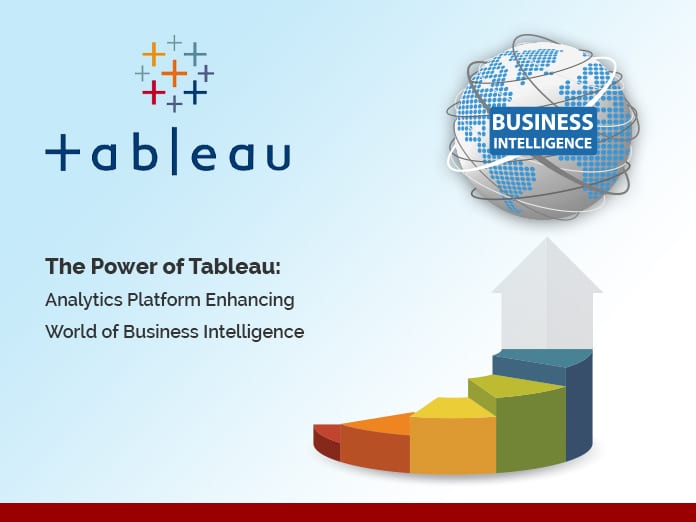Jump to Section
Introduction
Tableau is a Data Visualization and Analytical tool that is widely used for Business Intelligence and has numerous features. It helps to create interactive graphs and charts in the form of worksheets, dashboard, and stories to gain business insights. Also, it has the functionality to drag and drop.
Use Tableau to harness your data, elevate your insights, discover opportunities and experience the power of data throughout your analytical journey. Stay in the flow of data analysis, from data prep to analytics and data collaboration.
Key Features of Tableau
- Data Collaboration
- Data Modeling
- Data Blending
- Real-Time Data Analysis
Use Tableau and get connected to multiple data sources from files and servers. You can work on various file formats such as CSV, JSON, TXT, Excel or even get your data imported from servers like Tableau Server, MySQL, PostgreSQL, SQL Amazon Redshift and many more.
Tableau is the most powerful business intelligence tool with a flexible platform that provides an opportunity to your people with smart, visual, and direct access to their data for every step of the analytics journey.
Tableau interface makes it easy to learn and exciting to use. Its flexible architectural design will work in any environment and with your data.
When it comes to elevating data, only Tableau combines a laser focus on how people see and understand data with the kind of robust, scalable platform you need to run even the world’s largest organizations.
Types of Tableau Product
- Tableau Desktop
- Tableau Public
- Tableau Reader
- Tableau Server
- Tableau Online.
Tableau Desktop
Tableau Desktop comes with multiple features that allow you to code and customize reports. It also provides the feature to create interactive charts, reports and blend them to form dashboards and stories.
Tableau Desktop can connect with local servers as well as cloud servers to provide real-time data analysis and the created dashboard or files can be shared locally or publicly.
Tableau Desktop is classified into two categories based on publishing options:
- Tableau Desktop Personal: The development feature is similar but has limited access as the workbook will be private and the file can be distributed either offline or tableau public.
- Tableau Desktop Professional: It is similar to Tableau Desktop and the workbook created in the professional version can be published online and server. It also provides full access to the data type. Therefore, it is best suitable to publish a workbook on the tableau server.
Tableau Public
In Tableau Public, the workbook and dashboard cannot be saved locally as the name itself depicts “Public.” So, if the workbook is required to be shared, Tableau’s public cloud will be the one and only option. Since the saved files are on the cloud public, anybody can download it. Therefore, there is no security on the data over the Tableau Public.
Tableau Reader
Tableau Reader is a free tool that allows us to view the workbook created using Tableau Desktop and Tableau Public. This tool cannot modify or edit the data but can filter the data. The security level is zero in Tableau Reader as any individual who gets the exercise manual can see it utilizing Tableau Reader.
On the off chance that you need to share the dashboards that you have made, the collector ought to have Tableau Reader to see the document.
Tableau Server
To summarize, the Tableau Server is used to share the workbook, reports that are made in the Tableau Desktop application. To share dashboards in the Tableau Server, you should initially share your work in the Tableau Desktop. The shared workbook to the server can only be opened by authorized users.
In any case, it is not necessary that the authorized clients need to have the Tableau Server introduced on their machine. They simply require the log in credentials with which they can check reports by means of an internet browser. The security is high in Tableau Server, and it is much effective in sharing the data in an organization.
Tableau Online
In brief, the functionalities of Tableau Online are similar to Tableau Server. In addition, Tableau servers stores all the information from the Tableau Online. Tableau group maintains that information stored on the server. Tableau Online does not have any capacity limit to store data.
Whereas, Tableau Online connects to multiple data sources directly. Cloud host sources such as MySQL, AWS, Spark SQL, PostgreSQL, and many more.
Tableau Online and Tableau Server published the workbooks created by Tableau Desktop. It also supports data from the online streaming platform.
Thanks for reading. I hope you enjoyed the post. Please share it on your social platforms and share it with your friends, if you like it. We will be delighted to hear your feedback and comments. If you have any questions please feel free to ask them.
- Business Intelligence Vs Data Analytics: What’s the Difference? - December 10, 2020
- Effective Ways Data Analytics Helps Improve Business Growth - July 28, 2020
- How the Automotive Industry is Benefitting From Web Scraping - July 23, 2020



